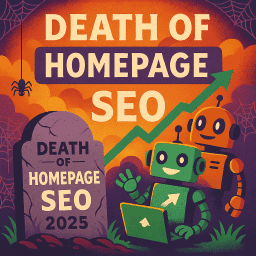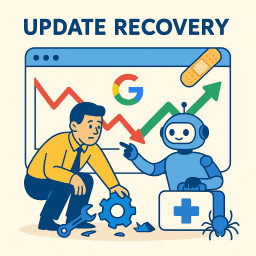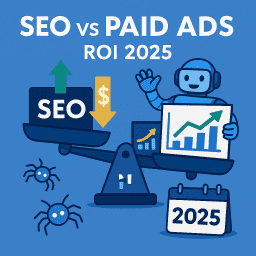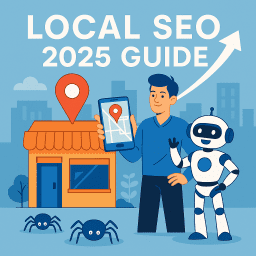Seven Fatal SEO Mistakes You Don’t Know You’re Making
These common errors could be killing your rankings
🔥 The SEO Pitfalls Even Pros Fall Into (And How to Fix Them)
Even seasoned business owners and marketers fall into traps that quietly sabotage their search engine performance. The worst part? Most of these SEO mistakes go completely unnoticed — until your traffic plummets and your rankings disappear.
In this post, we’ll uncover 7 surprisingly common SEO mistakes that could be holding your site back and show you exactly how to fix them.
❌ 1. Targeting the Wrong Keywords
It’s not about ranking for any keywords — it’s about ranking for the right ones.
Too many websites focus on vague or overly competitive terms they’ll never rank for, or they optimise for keywords their audience isn’t even searching.
Fix it:
- 🔍 Do proper keyword research using tools like Google Keyword Planner, Ubersuggest or SEMrush.
- 🎯 Focus on long-tail keywords with clear intent and achievable competition.
- 🗣️ Align content with real customer questions, not just keyword volumes.
🕳️ 2. Neglecting Meta Titles and Descriptions
Meta titles and descriptions may seem minor, but they directly impact click-through rates and rankings.
If your pages don’t have custom, compelling titles and descriptions, Google might generate them for you — often with poor results.
Fix it:
- ✏️ Write unique titles for every page (50–65 characters).
- 📝 Add meta descriptions (120–160 characters) that summarise the content and encourage clicks.
- 🔑 Include your focus keyword naturally in both.
📉 3. Ignoring Site Speed
Google has confirmed that page speed is a ranking factor. Users expect fast websites. If your site is slow, they’ll bounce — and Google will take note.
Fix it:
- 🖼️ Compress images and serve them in next-gen formats (like WebP).
- 🧼 Minimise plugins, scripts, and unnecessary code.
- 💨 Use caching and consider upgrading your hosting plan.
🔗 4. Weak Internal Linking
Without a solid internal linking strategy, your site becomes a disconnected mess. Google struggles to understand which pages matter most.
Fix it:
- 🔗 Link related blog posts and service pages together naturally.
- 🏠 Always link back to your homepage or key landing pages.
- 📚 Use descriptive anchor text (avoid “click here”).
🦴 5. Thin or Duplicate Content
If your pages are short, generic, or copied from elsewhere, they’ll likely be ignored by Google.
Fix it:
- 🧠 Provide real value — answer questions, solve problems, go deeper than competitors.
- ✍️ Aim for a minimum of 500 words per page (1,000+ for blogs).
- 🚫 Never duplicate content from other sites (or your own).
📱 6. Not Being Mobile-Friendly
Mobile-first indexing means Google primarily uses the mobile version of your site to rank it. If your site isn’t mobile-friendly, you’re at a massive disadvantage.
Fix it:
- 📱 Use responsive design that adapts to all devices.
- 🖱️ Make buttons and navigation touch-friendly.
- ⏱️ Keep mobile load speeds under 2 seconds.
📉 7. Not Tracking or Adapting
SEO isn’t “set and forget.” If you’re not monitoring performance, you’ll miss issues and opportunities to improve.
Fix it:
- 📈 Set up Google Analytics and Google Search Console.
- 🔄 Regularly check for crawl errors, drops in rankings, or content that needs updating.
- 🧪 Test and tweak page titles, CTAs, and keyword targeting monthly.
🧠 Final Thoughts
These SEO mistakes are easy to make — but also easy to fix once you know what to look for. Regular audits, smart content planning, and attention to technical details can make a huge difference over time.
SEO success doesn’t require tricks or hacks. It requires consistency, relevance, and a willingness to adapt.
Now you know the pitfalls. Time to start fixing them.
🔗 Related Resources from The SEO Guide Book
- If you’re completely new to search engine optimisation, our SEO Basics guide is a great place to start.
- Fixing issues like missing title tags or slow site speed? Check out our On-Page SEO guide for a full breakdown.
- Technical issues can silently hold your site back — our Technical SEO page covers the essentials.
- Not ready to hire an expert? Our DIY SEO guide will walk you through the steps.
- Want to make sure you’ve covered the basics? Download our Free SEO Checklist and follow along.
📝 Recap and Clarify: Post-Specific FAQs
What are the most common SEO mistakes?
Common SEO mistakes include ignoring user intent, keyword stuffing, duplicate content, broken links, poor site speed, and lack of mobile optimisation.
Can keyword stuffing harm my rankings?
Yes. Keyword stuffing is considered a spammy tactic and can result in lower rankings or even penalties from Google. Natural keyword use is essential.
Why is ignoring technical SEO a mistake?
Technical SEO ensures that search engines can crawl, index, and understand your website. Neglecting it can prevent your site from appearing in search results at all.
What is duplicate content and why is it bad?
Duplicate content refers to blocks of identical or very similar content on different URLs. It confuses search engines and can dilute your ranking potential.
Do broken links impact SEO?
Yes. Broken internal or external links create a poor user experience and can reduce crawl efficiency, which may negatively affect your SEO performance.
Is mobile optimisation really that important?
Absolutely. Google uses mobile-first indexing, so if your site doesn’t perform well on mobile devices, it will struggle to rank in search results.
Why is targeting the wrong keywords a fatal mistake?
Targeting keywords with high competition or no relevance to your audience can waste resources and fail to drive meaningful traffic or conversions.
How does poor content structure hurt SEO?
Unorganised content without clear headings, logical flow, or internal links makes it harder for users and search engines to understand your message and value.
Can ignoring local SEO harm my business?
Yes. If you’re a local business and neglect local SEO tactics like Google Business Profile or local keywords, you’ll miss out on valuable nearby search traffic.
How can I fix my SEO mistakes?
Start with a full SEO audit. Fix technical issues, update content, remove spammy tactics, and focus on user experience and long-term value. Small changes can lead to big results.


















